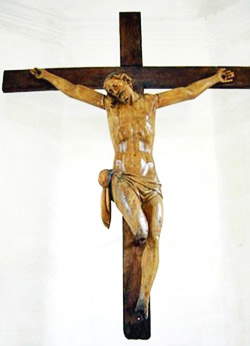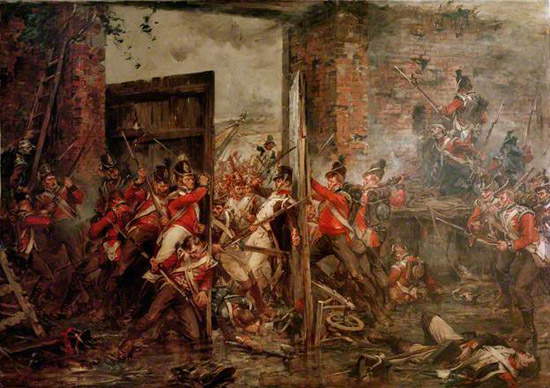Hougoumont crucifix: survived Waterloo, stolen and finally found
It is a work of art that would have remained almost anonymous were it not for the events of the story. Therefore, it is hard to imagine that such a work could have such a compelling story to tell. Yet, for the Hougoumont crucifix, this is indeed the case.
 |
| The Hougoumont crucifix |
Our work of art is a simple wooden crucifix, made around 1650 in Catholic Flanders. The Christ, almost two meters high, has massive proportions and a suffering air, as was typical of the art of the time: his suffering was meant to move the viewer, that is, the faithful. Especially since we are in a region that had been touched by the Protestant Reformation, though later successfully (but not without effort) “reconverted” to the Catholic faith. We do not know who the author of the work was.
The crucifix was originally located in the chapel of Hougoumont Castle, not far from the Waterloo near which took place the famous battle that sealed Napoleon Bonaparte’s final defeat: it was June 18, 1815. It was precisely around the castle that the first stages of the battle were fought. And then, more than a castle, it was a kind of fortified agricultural estate.
The Hougoumont fort was strategic for the purposes of the battle, and for several hours the French and the allies had to contend with it: the allies eventually prevailed, but the fort suffered heavy damage and was largely destroyed. The very chapel that held the crucifix was set on fire, but the crucifix managed to escape devastation. Victor Hugo, in his Les Miserables, also describes these excited moments: “Les flammes ont rempli cette masure; elle a été fournaise; la porte a brûlé, le plancher a brûlé, le Christ en bois n’a pas brûlé. Le feu lui a rongé les pieds dont on ne voit plus que les moignons noircis, puis s’est arrêté. Miracle, au dire des gens du pays” (“The flames filled the building, which became like a furnace: the door burned, the floor burned, the Christ did not burn. The fire attacked his feet, so we see nothing but a pair of amputated and blackened legs, but then it stopped. Miracle, according to the people of the village.”). Christ, in fact, completely lost his entire right leg from the knee down, and his left foot during the fire: to this day we still see the remaining extremities blackened by smoke.
 |
| Robert Gibb, The closing of the gates of Hougoumont Castle, 1903; Edinburgh, National Gallery of Scotland |
The battle then ended, Napoleon was exiled, the villagers began to rebuild the estate, and the crucifix began to become a minor celebrity: he was after all also a survivor of one of the most famous battles in history. And his home, the Hougoumont estate, has for some years been undergoing a complete recovery project (which can be followed constantly at www.projecthougoumont.com) that is to be finished in 2015, on the bicentennial of the battle. And, as we can well imagine, the bicentennial will give rise to many celebrations.
Perhaps taking advantage of the state the estate was in in 2011, some thieves broke into the chapel in February to steal the crucifix. The heist succeeded, but it is still unclear what the thieves’ objective was. A commissioned theft for a completely unscrupulous collector of Napoleonic relics? Or, given that the work is certainly not of high artistic value (in fact, far from it), an attempt to get people talking about himself and his action, and thus a way to seek attention? That is yet to be seen.
The fact is that, after the daring theft in 2011, there was no trace of the crucifix for three years. Until a few days ago: it was the Telegraph that reported on the find. The editors of the Hougoumont site learned of rumors that the crucifix had reappeared in a flea market in Wallonia. The police, put on alert, would therefore conduct investigations that enabled them to track down a man who had come into possession of the artwork: how, it is not known. But for now the important thing is that the Hougoumont crucifix has been found, and is back in the chapel. To the delight of all the people who are working towards next year’s celebrations, and those who will attend and travel to Waterloo and its environs. So a story with a happy ending: the anonymous wooden Christ will be able to prepare to be in full form in 2015!
Warning: the translation into English of the original Italian article was created using automatic tools. We undertake to review all articles, but we do not guarantee the total absence of inaccuracies in the translation due to the program. You can find the original by clicking on the ITA button. If you find any mistake,please contact us.



























